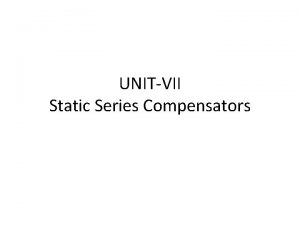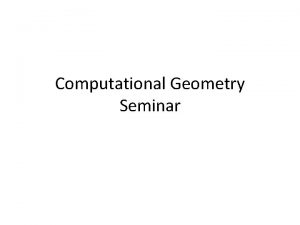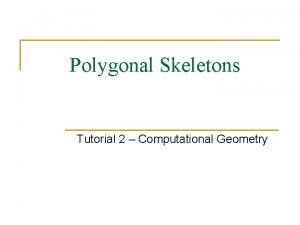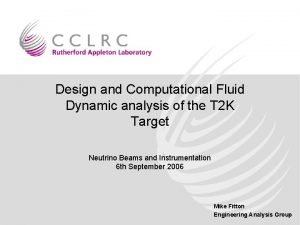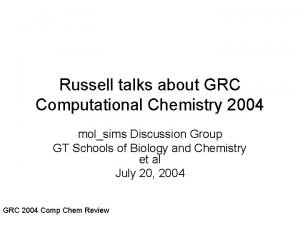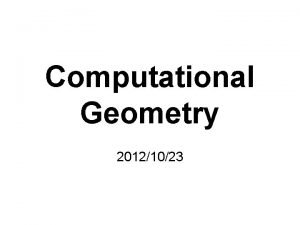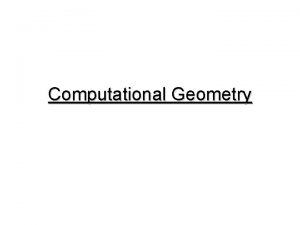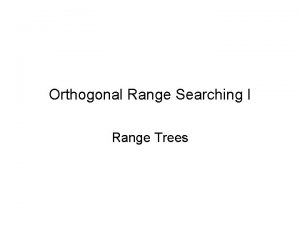Representing Range Compensators with Computational Geometry in TOPAS













- Slides: 13

Representing Range Compensators with Computational Geometry in TOPAS Forrest Iandola 1, 2 and Joseph Perl 1 SLAC National Accelerator Laboratory 2 University of Illinois at Urbana-Champaign 1

Overview • • • Medical Physics in 30 Seconds Introduction to TOPAS What is a range compensator? Subtraction Solid geometry Modeling compensators with Subtraction Solids Approximation with polyhedrons for (potentially) faster performance 2 Forrest Iandola Computational Geometry Compensators

Medical Physics in 30 Seconds • Goal: kill cancer with radiation • Deliver radiation with protons, photons, other particles, or ions • Monte Carlo simulation of proton therapy beams is an up-and-coming field 3 Forrest Iandola Computational Geometry Compensators

Introduction to TOPAS (Tool for Particle Simulation) • TOPAS = Monte Carlo simulation of radiation therapy beamlines • User can easily customize beamline for specific treatment facilities • Uses Geant 4 for the “real” physics 4 Forrest Iandola Computational Geometry Compensators

What is a Range Compensator? • A radiation therapy beamline collimates the beam and produces a specific energy spread • Range compensator produces an energy spread • Construction: drill a number of holes out of a cylinder of lucite • Each drill hole may have a unique depth • “The thickness of the Lucite [plastic] will proportionally reduce the depth [energy] of the protons” 1 1 http: //neurosurgery. mgh. harvard. edu/protonbeam/ 5 Forrest Iandola Computational Geometry Compensators

What is a Range Compensator? 6 Forrest Iandola Computational Geometry Compensators

Subtraction Solids • Geant 4 supports boolean solid combinatorial geometry – Subtraction solids – Union solids • It’s as simple as new. Solid = Solid 1 • Overlap among subtracted solids is acceptable • Solids can be recursively subtracted 7 Solid 2 Forrest Iandola Computational Geometry Compensators

Compensator with Subtraction Solids Compensator comprised of a big. Cylinder with n holes subtracted: new. Solid 1 = big. Cylinder - small. Cylinder 1 new. Solid 2 = new. Solid 1 - small. Cylinder 2 … Compensator = new. Solid(n-1) - small. Cylinder(n) 8 Forrest Iandola Computational Geometry Compensators

Compensator with Subtraction Solids 9 Forrest Iandola Computational Geometry Compensators

Approximation for Performance Gains • Approximate the drill holes with a collection of hexagons • Lack of overlap among hexagons allows us to model all hexagons as a single polyhedron • Future work: evaluate performance benefits (and accuracy reduction) with polyhedron method 10 Forrest Iandola Computational Geometry Compensators

Approximation for Performance Gains Subtraction Solid Polyhedron 11 Forrest Iandola Computational Geometry Compensators

Approximation for Performance Gains • Future work: evaluate performance benefits (and accuracy reduction) with polyhedron method 12 Forrest Iandola Computational Geometry Compensators

Acknowledgements • Harald Paganetti (Massachusetts General Hospital and Harvard University) • Jan Schuemann (Massachusetts General Hospital and Harvard University) • Jungwook Shin (UC San Francisco) • Bruce Faddegon (UC San Francisco) • DOE and NIH for generous support Contact: forrest@slac. stanford. edu 13 Forrest Iandola Computational Geometry Compensators
 List of static series compensators
List of static series compensators Computational geometry
Computational geometry Straight skeleton
Straight skeleton Pf3 molecular geometry
Pf3 molecular geometry Electron domain geometry vs molecular geometry
Electron domain geometry vs molecular geometry This molecule is
This molecule is As compared to long-range forecasts, short-range forecasts
As compared to long-range forecasts, short-range forecasts Chomsky computational linguistics
Chomsky computational linguistics Computational fluid dynamic
Computational fluid dynamic Computational linguist jobs
Computational linguist jobs Jeannette m. wing computational thinking
Jeannette m. wing computational thinking Computational security
Computational security Computational thinking jeannette wing
Computational thinking jeannette wing Grc computational chemistry
Grc computational chemistry
